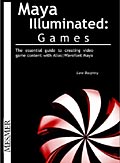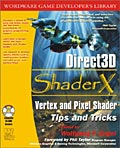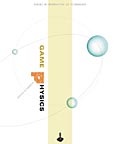|
|
 |
 |
 |
 |
Game Programming Books |
 |
 |
Maya Illuminated: Games - by Lane Daughtry, Brian Demong |
 |
 |
 |
 |
Maya Illuminated: Games is a comprehensive guide to the powerful tools Maya gives you to create stunning game art. Inside you’ll find exhaustive coverage of both Maya’s polygonal modeling and UV mapping toolsets. Also covered is information on character rigging and animation as they apply to game work, and ways to use Maya for going beyond low-poly work for games. This book is the perfect companion for working game artists and aspiring game artists alike.
Complete coverage of:
• The polygonal modeling toolset
• Polygonal modeling theory
• The UV mapping toolset
• UV mapping tips and tricks
• Character rigging issues for game content
• Animation issues for game content
• Other ways Maya can be used to create game art |
 |
 |
Learning Maya | Games and Interactive - by Alias |
 |
 |
|
 |
Learning Maya | Games and Interactive will provide you with the background you need to effectively use Maya for the creation of real-time applications. Developed by Alias Education Product Specialists, the book provides both theoretical exploration and practical application - each chapter includes conceptual discussions and step-by-step instructions. Also included are many helpful tips to help you better understand how Maya works, and how you can prepare your models and props for real-time output. Short presentations delivered by an Alias Certified Instructor are provided on the included cd-rom. The instructor provides additional theory, tips and suggestions on a chapter-by-chapter basis, giving you greater insight into the concepts explored in the book. |
 |
 |
Real-Time Rendering - by Tomas Moller, Eric Haines |
 |
 |
|
 |
One would think that the title of Tomas Moller's and Eric Haines's book, Real-Time Rendering, would be a contradiction in terms. How can such a computationally intensive process as rendering computer graphics ever hope to be done on the fly, in the blink of an eye, without delay--in short, in real time?
The term rendering, as it applies to computer graphics, refers to the mathematically intensive process of creating a picture or sequence of frames based on geometry. The duration of this process is dependent on the complexity of the scene (a forest with many trees and thousands of leaves will take much longer to render than a scene consisting of a white box over a gray background) and the speed of the hardware doing the calculations |
 |
 |
Real-Time Rendering (2nd Edition) - by Tomas Akenine-Moller, Eric Haines |
 |
 |
|
 |
One would think that the title of Tomas Moller's and Eric Haines's book, Real-Time Rendering, would be a contradiction in terms. How can such a computationally intensive process as rendering computer graphics ever hope to be done on the fly, in the blink of an eye, without delay--in short, in real time?
The term rendering, as it applies to computer graphics, refers to the mathematically intensive process of creating a picture or sequence of frames based on geometry. The duration of this process is dependent on the complexity of the scene (a forest with many trees and thousands of leaves will take much longer to render than a scene consisting of a white box over a gray background) and the speed of the hardware doing the calculations. |
 |
 |
Level of Detail for 3D Graphics - by David Luebke, Martin Reddy |
 |
 |
|
 |
Level of detail (LOD) techniques are increasingly used by professional real-time developers to strike the balance between breathtaking virtual worlds and smooth, flowing animation. Level of Detail for 3D Graphics brings together, for the first time, the mechanisms, principles, practices, and theory needed by every graphics developer seeking to apply LOD methods.
Continuing advances in level of detail management have brought this powerful technology to the forefront of 3D graphics optimization research. This book, written by the very researchers and developers who have built LOD technology, is both a state-of-the-art chronicle of LOD advances and a practical sourcebook, which will enable graphics developers from all disciplines to apply these formidable techniques to their own work. |
 |
 |
Real-Time Shading - by Marc Olano (Editor), John C. Hart (Editor) |
 |
 |
|
 |
Written for video game developers, scientists and engineers dealing with graphic models, and graphics professionals, this volume introduces the fundamentals and procedures of computer graphic shading. The authors discuss high-level shading languages such as RenderMan and present algorithms used in shading hardware. The final part of the text explores future trends. |
 |
 |
Direct3D ShaderX: Vertex and Pixel Shader Tips and Tricks with CDROM - xxx |
 |
 |
 |
 |
text |
 |
 |
Real-Time Shader Programming - by Ron Fosner |
 |
 |
|
 |
Now that PC users have entered the realm of programmable hardware, graphics programmers can create 3D images and animations comparable to those produced by RenderMan's procedural programs--but in real time. Here is a book that will bring this cutting-edge technology to your computer.
Beginning with the mathematical basics of vertex and pixel shaders, and building to detailed accounts of programmable shader operations, Real-Time Shader Programming provides the foundation and techniques necessary for replicating popular cinema-style 3D graphics as well as creating your own real-time procedural shaders. |
 |
 |
Game Programming Gems 3 - by Dante Treglia (Editor), Mark Deloura |
 |
 |
|
 |
This ALL NEW volume in the Game Programming Gems series is filled with ready-to-use expert techniques, ideas, and solutions for game developers. Innovative solutions that have been used successfully in commercial projects are provided, along with insightful tips and tools that reduce programming time and redundancy. Covering all the key areas of game development, this invaluable resource combines the ideas of over 70 professional developers. Each section is edited by an expert in the field to ensure that the ideas are original, accurate, and useful for a variety of game development projects. And in addition to covering Mathematics, Graphics, General Programming, Audio, and Artificial Intelligence, Game Programming Gems 3 also includes an all new section on Network and Multiplayer games. Ready-to-use source code is included for each algorithm and can be used immediately by advanced programmers. |
 |
 |
Game Programming Gems - by Mark DeLoura (Editor) |
 |
 |
|
 |
Aimed at the working (or aspiring) Visual C/C++ game programmer, Game Programming Gems contains over 60 programming tips that have been gathered from more than 40 working game gurus. It you want to build your own games or are interested simply in how games work, this text provides an intriguing glimpse into how the pros create state-of-the-art 3-D animation.
The guiding principle in this book is to publish the best available tips for game programming; most of these fit into 10 pages or fewer. But don't let the efficient presentation fool you; almost every one of these tips will be invaluable to any serious game developer. |
 |
 |
Game Programming Gems 2 - by Mark DeLoura (Editor) |
 |
 |
|
 |
Game Programming Gems 2, the second volume in this successful series, contains a completely new set of over 70 articles on diverse topics that can be used in your own game projects. Written by game programming experts, each contribution provides a hands-on solution to programming problems, or a creative method for reducing programming time and redundancy. Edited by Mark DeLoura, former editor-in-chief of Game Developer Magazine, and a group of top-notch area editors, this collection covers the major topics needed to develop a state-of-the-art game engine. Six comprehensive sections, including an all new section on audio programming, provide techniques that expert developers can implement immediately, and intermediate to beginning programmers can use to expand their skills and knowledge. This is a must-have reference that contains the wisdom and experience of over 40 seasoned game developers. |
 |
 |
Mathematics for 3D Game Programming & Computer Graphics - by Eric Lengyel |
 |
 |
|
 |
This book illustrates the mathematical concepts that a game developer would need to develop a professional-quality 3D engine. Although the book is geared toward applications in game development, many of the topics appeal to general interests in 3D graphics. It starts at a fairly basic level in areas such as vector geometry and linear algebra, and then progresses to more advanced topics in 3D programming such as illumination and visibility determination. Particular attention is given to derivations of key results, ensuring that the reader is not forced to endure gaps in the theory. The book assumes a working knowledge of trigonometry and calculus, but also includes sections that review the important tools used from these disciplines, such as trigonometric identities, differential equations, and the Taylor series. |
 |
 |
3D Game Engine Design: A Practical Approach to Real-Time Computer Graphics - by David H. Eberly |
 |
 |
|
 |
Aimed at the working Visual C++ game developer, 3D Game Engine Design provides a tour of mathematical techniques for 3-D graphics, and the source code that's used to implement them in state-of-the-art video game engines. If you work in the game industry (or would like to), this book will serve you well, because it delivers excellent best practices for algorithms and programming techniques that'll help your software keep up with the competition.
This text is a virtual encyclopedia of expertise that's based on the author's own work and research in the gaming industry. It provides the mathematical notation, algorithms, and C++ code (on the accompanying CD-ROM) that are needed to build fast and maintainable game engines. Early sections start with the basics, with the math that's used to work with common 3-D objects (like spheres and boxes). Highlights include a high-powered review of quaternion algebra--in many cases, the preferred way to transform 3-D data |
 |
 |
3D Math Primer for Graphics and Game Development - by Fletcher Dunn, Ian Parberry |
 |
 |
|
 |
3D Math Primer for Graphics and Game Development covers fundamental 3D math concepts that are especially useful for computer game developers and programmers. The authors discuss the mathematical theory in detail and then provide the geometric interpretation necessary to make 3D math intuitive. Working C++ classes illustrate how to put the techniques into practice, and exercises at the end of each chapter help reinforce the concepts. |
 |
 |
Geometric Tools for Computer Graphics - by Philip J. Schneider, David H. Eberly |
 |
 |
|
 |
Reinventing the wheel is a terrible waste of time, yet legions of computer programmers do exactly that every day. Geometric Tools for Computer Graphics gives the working graphics programmer a vast collection of programming examples, complex code snippets explained and ready to use. Each chapter is filled with more than just code examples--the explanations needed to understand why these examples work the way they do are given by authors with experience both in writing and in the field.
There is nothing here for the casual graphics programmer and everything for the serious 2-D and 3-D programmer. Thirteen chapters, three appendices, and a three-column index that spans over 30 pages cover everything about computer-graphic geometry, from the basics of using matrices and linear systems to intersecting 3-D objects. |
 |
 |
The Cg Tutorial: The Definitive Guide to Programmable Real-Time Graphics - by Randima Fernando, Mark J. Kilgard |
 |
 |
|
 |
"Cg is the key to unlocking the power of a new generation of programmable graphics hardware. This book is the definitive introduction to Cg, and will be essential for anyone programming high-quality real-time graphics. The Cg Tutorial will teach you to use Cg to create effects never before available for real-time applications."--Larry Gritz, Author of Advanced RenderMan (Morgan Kaufmann, 2000)
"An important and timely book: Pixel-level procedural textures--animated clouds, fire, water, the whole bag of procedural tricks--finally go from the movie screen to the desktop. Access to computation of this power through a C-like language will usher in an exciting new era for the graphics community."--Ken Perlin, Professor, New York University |
 |
 |
Game Physics - by Dave Eberly |
 |
 |
 |
 |
Game Physics is an introduction to the ideas and techniques necessary to create physically realistic 3D graphic environments. As a companion volume to Dave Eberly's industry standard 3D Game Engine Design, Game Physics shares a similar practical approach and format. Dave includes simulations to introduce the key problems involved, and then gradually uncovers the mathematical and physical concepts necessary to solve them. He then describes all of the algorithmic foundations, and uses code examples and working source code to show how they are implemented culminating in a complete physics engine. This book tackles the complex issues others avoid and that challenge professional designers, including rigid body dynamics, impulse methods, penalty methods, resting contact, linear complementarity problems, deformable bodies, mass-spring systems, friction, numerical solution of differential equations, numerical stability and its relationship to physical stability, and symplectic systems. |
 |
 |
Physics for Game Developers - by David M. Bourg |
 |
 |
|
 |
Aimed at the game developer or student/hobbyist interested in physics, Physics for Game Developers reviews all the math for creating realistic motion and collisions for cars, airplanes, boats, projectiles, and other objects along with C/C++ code for Windows. While this authoritative guide isn't for the math-averse, the author's clear presentation and obvious enthusiasm for his subject help make this book a compelling choice for anyone faced with adding realistic motion to computer games or simulations.
It's the clear, mathematical presentation here that makes this title a winner. Starting with the basics of Newtonian mechanics, the author covers all the basic equations needed to understand velocity, acceleration, kinematics, and kinetics, among other concepts. A knowledge of college math (including calculus) is assumed. (Appendices review the basics of matrix and quaternion mathematics for those needing a refresher.) |
|
 |
 |
|
 |
|
